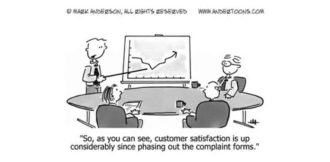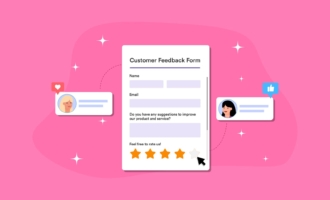Your customer feedback loop is made up of all the tactics and tools your company uses to encourage, collect, and respond to customer feedback.
Admittedly, there’s plenty of data that confirms what you’ve probably already guessed: people love to vent when they’re frustrated, but when things are going great? Silence. Yet both sets of customers have valuable feedback to offer, and creating a feedback loop can improve your service and minimize churn.
Given that it costs between five and seven times more to acquire a new customer than it does to retain an existing one (even one who’s briefly upset), creating an empathetic, responsive customer feedback loop is worth the effort. After all, at least you have a chance to make things right with a dissatisfied customer.
So, how do you build such a loop? Here are a few tips.
Welcome customer feedback and act on it
Without customer feedback, you obviously can’t get a clear picture of what people think of your company and the products and services you offer — and neither can potential customers. Before making a buying decision, many people will scan social media for recommendations and opinions. Knowing what customers like and dislike, and why they return to buy more or never come back, is just as important for them as it is for you.
Of course, actually getting this feedback from customers requires a delicate balance. You want to get as much information as you can without making them feel interrogated or that you’re imposing on their time. What’s more, you’d much rather an unhappy customer give their feedback to you directly rather than to the rest of the world through an angry online review. That’s why you need to provide plenty of easy and obvious ways to voice complaints or praises.
A simple Likert scale survey template from Jotform is an effective way to gather measurable customer feedback. You can embed it on your website, or share it via email, social media, or a form link.
But no matter how you plan to get customer feedback, be ready to make good use of it. If someone indicates that a customer service agent needs training, make it happen. If a certain process is frustrating customers, resulting in shopping cart abandonment or poor online reviews, follow up right away. It’s a good idea to assume many other people have had the same dissatisfying experience but haven’t said anything (at least to you).
Pro Tip
Gather real-time customer feedback with Jotform AI Agents, offering instant assistance and capturing valuable insights while enhancing the customer experience.
Respond to customer feedback
There are many ways to get it wrong when you’re trying to build a customer feedback loop. Perhaps the most common one is asking for feedback but not being prepared to respond beyond a generic response like, “Thank you for your feedback. It’s under review.” Once you get the customer feedback you asked for, acknowledging the complaint or praise is your next step in the process. And make sure you take that step quickly, or you’ll risk alienating the customer.
If it’s a complaint, you need to consider the feedback carefully and empower your customer service representatives with a range of options for resolving it. It’s important to train front-line managers and grant them the discretion to respond to negative feedback with a refund or replacement item — or something that satisfies the customer. That way, you turn it into a positive customer experience.
Got some glowing praise? A sincere thank you is a minimum. But if you want to make a permanent friend, a future discount can work wonders. The people who praise your products and services are also the likeliest candidates to be brand ambassadors. Jotform has a brand ambassador application template and a brand ambassador contract template to make the process easier if you’re interested in this marketing strategy.
Use the right customer feedback tools
Finally, remember that customer feedback isn’t a distraction to be avoided — it’s an invaluable source of insight that’s impossible to duplicate from inside the company. So, you want to make it as easy as possible to gather, learn from, and act on.
Jotform has over 400 feedback forms to simplify your collection efforts. Then, you can use a Jotform customer feedback log to manage and analyze the responses. Once you’ve made things right with the customer, it’s time to give constructive feedback to your managers and team members. This is essential for their growth, both personally and professionally.
Any strategy for success needs to incorporate feedback in all its forms to achieve its goals. Get started with Jotform today to take your products, services, and customer experience to the next level.
Photo by cottonbro studio


















Send Comment: